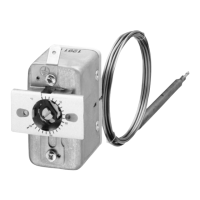31
7 Technical data
NOTE:
Upon request the capillary length can be increased up to a maximum of 5,000 mm if the allowable tem-
perature on the sensor, capillary, and switching head is not reached.
Please let us know the actual temperature values to which the thermostat is exposed.
7.4 Electrical data
Switching element
1, 2, 3, or 4 single-pole snap-action
switches
EM-1, EM-2, EM-3,
EM-20, EM-30
EM-4, EM-5,
EM-40, EM-50
EM-4.../U, EM-5.../U,
EM-40/U, EM-50/U
Microswitch
with changeover contact
Microswitch
with N/C contact and re-
start lock
Microswitch
with N/C contact, restart
lock, and additional sig-
nal contact
Maximum switching capacity Switching function
Switching differential
N/C contact,
terminal 2
N/O contact,
terminal 4
TR, TW, STB (STB)
2.5 %, 5 %, 6 %, 7 %,
10 %
AC 230 V +10 %
16 (3) A, cos = 1 (0.6)
DC 230 V +10 %, 0.25 A
AC 230 V +10 %
8 (1.5) A, cos = 1 (0.6)
DC 230 V +10 %, 0.25 A
TB, STB AC 230 V +10 %
16 (3) A, cos = 1 (0.6)
DC 230 V +10 %, 0.25 A
AC 230 V +10 %
2 (1) A, cos = 1 (0.6)
DC 230 V +10 %, 0,25 A
TR, TW
1%, 3%
AC 230 V +10 %, 6 (2) A, cos = 1 (0.6),
DC 230 V +10 %, 0.25 A
TR, TW
2.5 %
Microswitch with gold plating, extra code 702,
AC/DC 24 V, 0.1 A
Contact reliability To ensure the greatest possible switching reliability we recommend a minimum
load of:
For silver contacts: AC/DC 24 V, 100 mA
For gold-plated contacts (extra code 702): AC/DC = 10 V, 5 mA
Rating surge voltage 2500 V (via the switching contacts 400 V)
Overvoltage category II
Required fuse rating See maximum switching capacity
Electrical connection Standard: Tab connector A 6.3 × 0.8 DIN 46244
Extra code 699: Screw connection up to 2.5 mm
2
conductor cross section
(available at extra cost), also suitable for retrofitting

